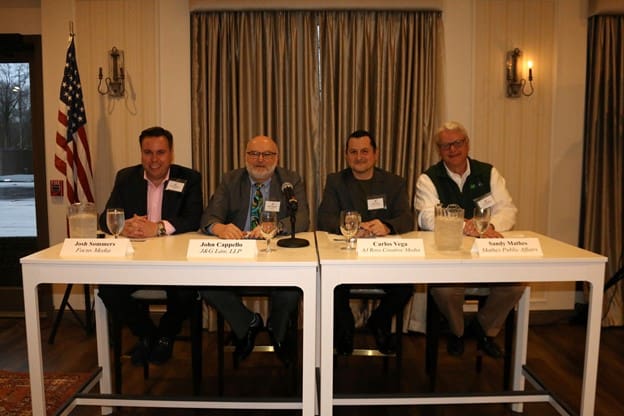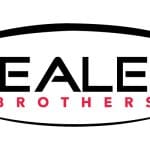ABG Tackles Important Issue: ‘Overcoming Opposition Through Community Engagement’
(Courtesy Orange County Partnership)
The Alliance for Balanced Growth and the Orange County Partnership jointly staged a highly informative session geared at helping developers, pro-growth advocates and communities overcome project opposition that can easily jeopardize worthwhile economic development projects via misinformation spread in media outlets.
The program entitled “Overcoming Opposition Through Community Engagement” was held on Feb. 23 at The Country Club at Otterkill in Campbell Hall and featured public relations, advertising, public affairs and legal experts who have worked on some of the most highly successful project proposals in the region. The panel consisted of Josh Sommers, president and CEO of Focus Media in Goshen; Carlos Vega, partner and creative director of AJ Ross Creative Media of Chester; Sandy Mathes, president of Mathes Public Affairs in Coxackie and John Cappello, partner of J&G Law, LLP of Walden. The panel was moderated by Conor Eckert, vice president of business attraction for the Orange County Partnership of Goshen.
The panelists were in agreement that transparency and a willingness to provide all information to the public in the early stages of the approval process were critical factors in getting out in front of project opponents. All also noted that in any development project approval process, there are legitimate concerns raised by residents that must be addressed if the project is to be successful.
The panel’s focus, however, was centered on how the best of development projects could be delayed or defeated by misinformation spread in stories published in print and broadcast media and particularly on social media.
Sommers, whose firm Focus Media, was a consultant on the successful LEGOLAND New York project in Goshen as well as the Resorts World Catskills development in Monticello, said the developer should do its due diligence before it begins navigating the approval process.
“Overall, what I find is that developers sometimes don’t do their visionary work in advance of the project and they call the public relations firm at the last minute and need a supermajority on the ZBA Board two weeks later,” Sommers said.
He said the best thing a developer can do is to get out in front and engage with the public and municipal officials about the merits of the project and “not let disinformation define a project.”
Sommers said that his firm’s job is to get the information out to the public and the media, answer resident questions about the proposal and foster a “proactive engagement with the community.”
He noted that there is a certain segment of the population that will not be swayed no matter the merits of the project and that is where organizations such as the Orange County Partnership and the Orange County Chamber of Commerce can be valuable whereby if they support the proposal, they will appear at public hearings to promote the merits of the development. He said with those organizations’ “built-in-constituency” they can help “move the needle” in the direction of securing approvals for the project.
Cappello stressed that developers must be forthright and inform the public about legitimate project impacts, such as environmental and traffic issues, and provide information on how those will be addressed.
He noted that developers need to get out in front and confront “the rumor mill” that spreads misinformation about the project. “If you are not out in front of it, it’s like trying to put the genie back in the bottle,” he said. At the onset of the proposal, the developer should hold meetings with regulators as well as the community to get the accurate information on the project out to the public, Cappello related.
Vega, whose firm was engaged with Medline on its proposed warehouse/distribution facility in Montgomery, said that transparency was the key to the success of that project. AJ Ross worked to create fact sheets and online community engagement that answered resident questions in real time and in many cases “answered questions before they were even asked.”
“You have to look at your company as if everybody can see every aspect of the project,” Vega related. “And then look for vulnerabilities.”
In addition, the developer should also pinpoint what positive impacts the project will have on the community and also identify the opposition and understand what their issues with the development actually are.
“A lot of times you will find out the opposition isn’t as big as it (originally) seemed,” Vega said.
Mathes said that no matter how staunch the opposition to a project is, a developer must remain respectful or it risks losing community support. He said the developer must work to educate the opposition or as he termed it in some cases “The Beast” that are in most cases anti-growth.
The developer needs to continue to work on providing the moderate opposition with the true facts of the project and during the regulatory process the opposition will be whittled down to just the anti-growth contingent. Such a plan eventually results in “everybody else starts to see them (“The Beast”) for what they are, and you win the community.”
He noted that in most communities there are very well-educated people who are versed in environmental, traffic and health arenas. Mathes advised that rather than do battle with these experts, he created an Advisory Board of the “smartest and most brilliant opposition” in order to find out “what is important to them…what is truly important to the community,” such as open space, habitat protection.
Mathes advised that developers in their interactions with government and the community “better be sincere and you better be truthful, or the community will see right through you if you are playing the game.”
The sponsors of the program were: Holt Construction, J&G Law, Focus Media and Engineering Surveying Properties.
Source: Orange County Partnership





